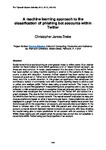A machine learning approach to the classification of phishing bot accounts within Twitter
| dc.contributor.author | Brake, C. | |
| dc.date.accessioned | 2019-05-20T16:13:19Z | |
| dc.date.available | 2019-05-20T16:13:19Z | |
| dc.date.issued | 2017 | |
| dc.identifier.citation |
Brake, C. (2017) 'A machine learning approach to the classification of phishing bot accounts within Twitter', The Plymouth Student Scientist, 10(2), p. 208-223. | en_US |
| dc.identifier.issn | 1754-2383 | |
| dc.identifier.uri | http://hdl.handle.net/10026.1/14166 | |
| dc.description.abstract |
Social network bots are becoming an ever-greater threat to online users. Most studies carried out have looked at bots which generate a lot of tweets known as spam, as these are very common. In recent years research into the area of bots within Twitter has been carried out using machine learning to attempt to find patterns in these ac-counts to aide with detection. However, limited research has been carried out that focuses on a sub set of Twitter bots which are involved in phishing campaigns which tweet very little to avoid detection. In this project an application was developed that combines a variety of commercial tools with machine learning theory to allow a user to collect and analyse public Twitter data using a neural network. The focus of the project is to try and find patterns in these phishing bots’ properties and to use the data collected to train a neural network to recognise these patterns and detect bots. A Twit-ter crawler was developed that harvests data from the Twitter API and stores it in a graph database. The data is then formatted and normalised by a pre-processor mod-ule which is then fed into a neural network. The neural network evaluates the data and creates predictions based on what it has previously learnt, these predictions are then displayed in a graph format within the browser. Experimental results have shown that there is a pattern in the properties of an account, and tests showed a correlation in the friend to follower ratio of bot accounts. With this pattern and other properties of an account, a neural network has been trained to detect bot accounts, with tests showing the neural being able to make predictions for an account with an accuracy of 92%. Whilst these results are still experimental the project has proven that is it possible to detect bots within Twitter using just the properties of an account. | en_US |
| dc.language.iso | en | en_US |
| dc.publisher | University of Plymouth | |
| dc.rights | Attribution 3.0 United States | * |
| dc.rights.uri | http://creativecommons.org/licenses/by/3.0/us/ | * |
| dc.subject | en_US | |
| dc.subject | phishing bot accounts | en_US |
| dc.subject | machine learning | en_US |
| dc.title | A machine learning approach to the classification of phishing bot accounts within Twitter | en_US |
| dc.type | Article | |
| plymouth.issue | 2 | |
| plymouth.volume | 10 | |
| plymouth.journal | The Plymouth Student Scientist |



